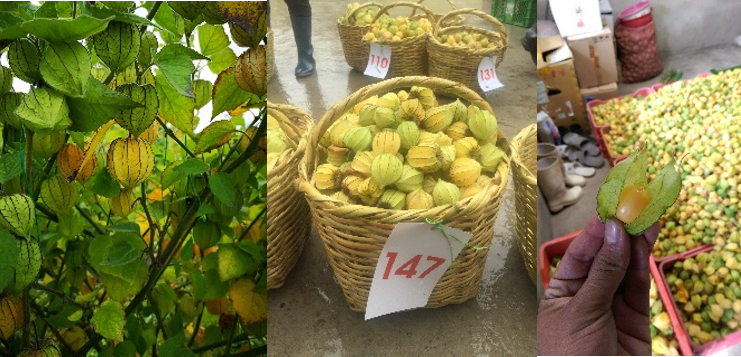Fruit characterization of 36 cape gooseberry hybrids for identification of potential industrial or fresh consumption uses

Abstract
The cape gooseberry is the second most exported fruit in Colombia. There are, however, little information available on genetic improvement processes and limited research on the fruit components. The objective of this study was to characterize the fruits of 36 hybrids, obtained from double haploid cape gooseberry lines from the Tibaitatá Research Center of the Colombian Corporation for Agricultural Research. Hybrids with potential uses in transformation processes or for fresh consumption were identified using Hierarchical Cluster (HC) and Principal Component Analysis (PCA) with 20 physical, physicochemical, compositional, and physiological fruit descriptors, obtained from four trials in the Andean region of southern Colombia. According to the PCA, three components represented 73.6% of the total variability: postharvest (37.5%), sensory and nutritional quality (21.3%) and cracking percentage (14.8%). Six conglomerates were identified. Groups two, four, and six had aptitude for fresh consumption because of the size of the berry, high vitamin C content, maturity index and low cracking levels. Group one showed aptitude for processing and fresh consumption. Groups three and five registered a high seed content, low maturity rates, and a high cracking percentage.
Keywords
Physalis peruviana, Andean crops, Fruit maturation, Ascorbic acid, Fruit cracking, Genetic improvement, Agroindustry
References
AOAC, Association of Official Analytical Chemists. 1990. Official methods of analysis of the Association of Official Analytical Chemists. 15th ed. Arlington, TX.
Balaguera-López, H.E., C.A. Martínez, and A. Herrera-Arévalo. 2014. Papel del cáliz en el comportamiento poscosecha de frutos de uchuva (Physalis peruviana L.) ecotipo Colombia. Rev. Colomb. Cienc. Hortic. 8(1), 181-191. Doi: 10.17584/rcch.2014v8i2.3212
Chasquibol, N. and J.C. Yácono. 2015. Composición fitoquímica del aceite de las semillas del fruto de “aguaymanto”, Physalis peruviana L. Rev. Soc. Quím. Perú 81(1), 311-318. Doi: 10.37761/rsqp.v81i4.36
Cortés, G.M., G.A. Prieto, and W.E. Rozo. 2015. Caracterización bromatológica y fisicoquímica de la uchuva (Physalis peruviana L.) y su posible aplicación como alimento nutracéutico. Cienc. Desarro. 6(1), 87-97. Doi: 10.19053/01217488.3653
Fischer, G., A. Herrera, and P.J. Almanza. 2011. Cape gooseberry (Physalis peruviana L.). pp. 374-396. In: Yahia, E.M. (ed.). Postharvest biology and technology of tropical and subtropical fruits. Woodhead Publishing Limited, Oxford, UK. Doi: 10.1533/9780857092762.374
Fischer, G., G. Ebert, and P. Lüdders. 2007. Production, seeds and carbohydrate contents of cape gooseberry (Physalis peruviana L.) fruits grown at two contrasting Colombian altitudes. J. Appl. Bot. Food Qual. 81, 29-35.
Fischer, G. and L.M. Melgarejo. 2020. The ecophysiology of cape gooseberry (Physalis peruviana L.) - an Andean fruit crop. A review. Rev. Colomb. Cienc. Hortic., 14(1), 76-89. Doi: 10.17584/rcch.2020v14i1.10893
García-Arias, F.L., J.A. Osorio-Guarín, and V.M. Núñez. 2018. Association study reveals novel genes related to yield and quality of fruit in cape gooseberry (Physalis peruviana L.). Front. Plant Sci. 9(1), 362. Doi: 10.3389/fpls.2018.00362
Herrera, A., G. Fischer, and M.I. Chacón. 2012. Agronomical evaluation of cape gooseberries (Physalis peruviana L.) from central and north-eastern Colombia. Agron. Colomb. 30(1), 15-24.
Icontec, Instituto Colombiano de Normas Técnicas y Certificación. 1999. NTC 4580: Frutas frescas. Uchuva. Especificaciones. Bogota.
Lagos-Burbano, T.C., D.F. Mejía-España, O. Arango-Bedoya, Z.Y. Villaquirán-Samboni, L.K. Lagos-Santander, and D.E. Duarte-Alvarado. 2020. Physicochemical properties of Colombian cape gooseberry hybrids in the selection of high-quality materials. Pesq. Agropec. Bras. 55, e01905. Doi: 10.1590/s1678-3921.pab2020.v55.01905
Málaga, R., A. Guevara, and M. Araujo. 2013. Efecto del procesamiento de puré de aguaymanto (Physalis peruviana L.), sobre los compuestos bioactivos y la capacidad antioxidante. Rev. Soc. Quím. Perú 79(1), 162-174.
Morillo, A.T., D.E. Villota, T.C. Lagos, and H.R. Ordóñez. 2011. Caracterización morfológica y molecular de 18 introducciones de uchuva Physalis peruviana L. de la colección de la Universidad de Nariño. Rev. Fac. Nac. Agron. Medellin 64(1), 6043-6053.
Pérez-Herrera, A., G.A. Martínez-Gutiérrez, F.M. León-Martínez, and M.A. Sánchez-Medina. 2019. The effect of the presence of seeds on the nutraceutical, sensory and rheological properties of Physalis spp. fruits jam: a comparative analysis. Food Chem. 302(1), 125-141. Doi: 10.1016/j.foodchem.2019.125141
Ramadan, M.F. 2011. Bioactive phytochemicals, nutritional value, and functional properties of cape gooseberry (Physalis peruviana): An overview. Food Res. Int. 44(7), 1830-1836. Doi: 10.1016/j.foodres.2010.12.042
Ramadan, M.F., N.A. Hassan, R.M. Elsanhoty, and M.Z. Sitohy. 2013. Goldenberry (Physalis peruviana) juice rich in health-beneficial compounds suppresses high-cholesterol diet-induced hypercholesterolemia in rats. J. Food Biochem. 37(6), 708-722. Doi: 10.1111/j.1745-4514.2012.00669.x
Ramírez-Nieto, N., Y. Baena, and C. Osorio. 2019. Caracterización fisicoquímica de emulsiones aceite/ agua a partir de uchuva (Physalis peruviana) como ingrediente para la industria alimenticia. Inf. Tecnol. 30(3), 147-156. Doi: 10.4067/S0718-07642019000300147
Sánchez, E., F.L. García, L. Suescún, M. Gómez, and V.M. Núñez. 2011. Producción de plantas genéticamente puras de uchuva. Cámara de Comercio de Bogotá, Bogota.
Sánchez, E.P., F.G. Mayorga, A.A. Navas, L.F. Gómez, and V.M. Núñez. 2016. Corpoica Dorada: variedad de uchuva para Boyacá, Cundinamarca y Antioquia. Corporación Colombiana de Investigación Agropecuaria (Agrosavia), Mosquera, Colombia.
Singh, D.B., S. Lal, N. Ahmed, O.C. Sharma, A.A. Pal, and A. Mirza. 2013. Diversity assessment in cape gooseberry (Physalis peruviana L.) genotypes. Madras Agric. J. 100(4/6), 273-276.
Vignoni, L.A., R.M. Césari, M. Forte, and M.L. Mirábile, 2006. Determinación de indice de color en ajo picado. Inf. Tecnol. 17(6), 63-67. Doi: 10.4067/S0718-07642006000600011
Yazdanpour, F., A. Khadivi, and A. Etemadi-Khah. 2018. Phenotypic characterization of black raspberry to select the promising genotypes. Sci. Hortic. 235, 95-105. Doi: 10.1016/j.scienta.2018.02.071
